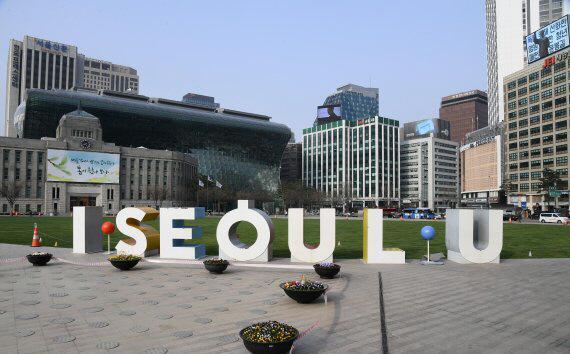Single-person households in Seoul outnumber other kinds
Emergencies most difficult challenge for younger people; older people say loneliness, economic anxiety are worse
By Shin Ji-hyePublished : April 29, 2021 - 13:48

Single-person households accounted for 33.3 percent of all households in Seoul, making them the most common type of household in the city. The hardest part of living alone was difficulty coping with sickness or emergencies, a survey showed Thursday.
The Seoul Metropolitan Government announced the results of its 2020 Seoul Welfare Survey, which involved 4,000 households and took place over two months beginning in November.
After single-person households, the next most common were two-person households, which accounted for 25.8 percent of the total. Three-person households made up 20.6 percent and four-person households made up 19.2 percent.
Younger people (aged 19 to 34) accounted for the highest proportion of single-person households, 41.2 percent. Senior citizens (aged 65 and older) followed at 22.6 percent and middle-aged people (aged 50 to 64 years) at 16.2 percent.
For younger people, the biggest reason for living alone was to be close to work or school (81.5 percent). Middle-aged people and senior citizens were more likely to live alone due to divorce, separation or the death of a spouse, with 68.5 percent of middle-aged respondents and 80.3 percent of older respondents choosing this answer.
Of the younger respondents who lived alone 71 percent were satisfied with the situation, compared with 41.5 percent of middle-aged respondents and 43.7 percent of elderly respondents.
The most difficult things about living alone were difficulty coping with emergencies (32.5 percent), loneliness (23.3 percent) and economic anxiety (20.3 percent). Young people who lived alone cited difficulty in coping with emergencies (42.1 percent) as the top priority, while middle-aged people cited loneliness (33.1 percent) and elderly people picked economic anxiety (34.3 percent).
The average monthly income for young respondents was 2.71 million won ($2,447) -- 2.24 million won for people in their 20s and 3.51 million won for those in their 30s. The highest proportion of younger respondents, 51.8 percent, paid monthly rent with a deposit.
Of the middle-aged respondents, 90.3 percent said they were willing to work even after retirement and 32.8 percent were not prepared for retirement. Reasons for wanting to work after retirement included the need to pay living expenses (66.3 percent), the need to support parents or children (13.9 percent) and the desire to contribute to society (13.2 percent).
For older respondents, the average monthly income was 2.86 million won and the poverty rate stood at 15.2 percent -- much higher than the 4.2 percent poverty rate posted for all households across age groups.
The average monthly income needed to maintain a minimum standard of living in Seoul was estimated at 2.96 million won, Seoulites said.
The annual average household gross income was 50.82 million won, up slightly from 2018. Forty-four percent of households in Seoul held debt, and the average amount was 99.78 million won.
Kim Sun-soon, head of the Seoul Metropolitan Government’s welfare policy office, said, “We will improve the quality of life of Seoul citizens by using the results of the survey as basic data to establish policies for single-person households.”
By Shin Ji-hye (shinjh@heraldcorp.com)
The Seoul Metropolitan Government announced the results of its 2020 Seoul Welfare Survey, which involved 4,000 households and took place over two months beginning in November.
After single-person households, the next most common were two-person households, which accounted for 25.8 percent of the total. Three-person households made up 20.6 percent and four-person households made up 19.2 percent.
Younger people (aged 19 to 34) accounted for the highest proportion of single-person households, 41.2 percent. Senior citizens (aged 65 and older) followed at 22.6 percent and middle-aged people (aged 50 to 64 years) at 16.2 percent.
For younger people, the biggest reason for living alone was to be close to work or school (81.5 percent). Middle-aged people and senior citizens were more likely to live alone due to divorce, separation or the death of a spouse, with 68.5 percent of middle-aged respondents and 80.3 percent of older respondents choosing this answer.
Of the younger respondents who lived alone 71 percent were satisfied with the situation, compared with 41.5 percent of middle-aged respondents and 43.7 percent of elderly respondents.
The most difficult things about living alone were difficulty coping with emergencies (32.5 percent), loneliness (23.3 percent) and economic anxiety (20.3 percent). Young people who lived alone cited difficulty in coping with emergencies (42.1 percent) as the top priority, while middle-aged people cited loneliness (33.1 percent) and elderly people picked economic anxiety (34.3 percent).
The average monthly income for young respondents was 2.71 million won ($2,447) -- 2.24 million won for people in their 20s and 3.51 million won for those in their 30s. The highest proportion of younger respondents, 51.8 percent, paid monthly rent with a deposit.
Of the middle-aged respondents, 90.3 percent said they were willing to work even after retirement and 32.8 percent were not prepared for retirement. Reasons for wanting to work after retirement included the need to pay living expenses (66.3 percent), the need to support parents or children (13.9 percent) and the desire to contribute to society (13.2 percent).
For older respondents, the average monthly income was 2.86 million won and the poverty rate stood at 15.2 percent -- much higher than the 4.2 percent poverty rate posted for all households across age groups.
The average monthly income needed to maintain a minimum standard of living in Seoul was estimated at 2.96 million won, Seoulites said.
The annual average household gross income was 50.82 million won, up slightly from 2018. Forty-four percent of households in Seoul held debt, and the average amount was 99.78 million won.
Kim Sun-soon, head of the Seoul Metropolitan Government’s welfare policy office, said, “We will improve the quality of life of Seoul citizens by using the results of the survey as basic data to establish policies for single-person households.”
By Shin Ji-hye (shinjh@heraldcorp.com)



















![[Today’s K-pop] Treasure to publish magazine for debut anniversary](http://res.heraldm.com/phpwas/restmb_idxmake.php?idx=642&simg=/content/image/2024/07/26/20240726050551_0.jpg&u=)